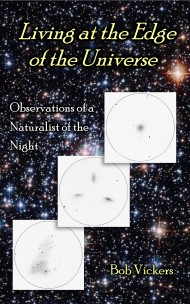The skies last Saturday night turned out to be much better than I thought they would. Daytime clouds dissipated and the evening stars appeared. After checking on the new supernova (SN2014J) in M82, which was quite easy to see, I decided to turn my scope to something closer to home but a lot harder to see. In addition to its four Galilean moons, Jupiter has at least one more moon that is visible in amateur telescopes. It is called Himalia, a 170 km (102 mile) diameter hunk of rock orbiting way outside the orbits of Io, Europa, Ganymede, and Calisto. It was discovered by Charles Dillon Perrine at the Lick Observatory in 1904. It has an orbital period of 251 Earth days and a visual brightness between 14th and 15th magnitude. Being this dim it is easily overwhelmed by Jupiter’s glare when it is close to the planet. Fortunately, its orbit takes it as much as a degree from Jupiter (equivalent to the diameters of two full Moons side by side) and this is the best time to view it. Himalia has been on my bucket list since I read an article in the September 2000 issue of Sky & Telescope magazine titled Moons of the Outer Planets by Roger W. Sinnott, but I only just recently researched how to find it in the telescope. I began (as I do most of my research projects nowadays) with a Google search for “Observing Himalia.” The search turned up two sources of information: The Whassupinthemilkyway.blogspot.com posts for Saturday December 10, 2011, & Monday August 13, 2012, by Karen Keese, which references an earlier online article (http://www.astronomy.net/articles/18/) by Rick Scott from October 20, 2003, which also references the aforementioned Sky & Telescope article. Given these guides and Jupiter’s recent opposition, I figured that now was the perfect time to try for Himalia.
I pretty much followed Karen’s instructions so I will not go into great detail here but will instead send you to her article for a step-by-step guide. I went first to the JPL Horizons website and generated an ephemeris for Himalia for the evening which showed its exact position in the sky (Right Ascension and Declination) at hourly intervals. I chose one time listing, in this case for 2300 CST or 0500 UT, as my projected time of observation. I then went to the Digitized Sky Survey (DSS) website and entered the coordinates. I produced two star field printouts, one at 30’ x 30’ and one at 15’ x 15’. I was able to match one approximately 7.5 magnitude star in the 30’ x 30’ printout with one of my Uranometria charts covering the lower half of Gemini. I also used a ruler to draw reticle lines to bracket the exact spot on the 15’ x 15’ printout where Himalia should appear.
Armed with charts, printouts, and a great deal of enthusiasm, I went back out to the scope to begin my search. Beginning at the star Mekbuda in Gemini, I then found 36d Gem through the finder and starhopped a little over one degree to the northeast and the 7.5 mag star shown on the Uranometria chart. This was the star that was also on the 30’ x 30’ printout. Near the center of the printout (Himalia’s theroretical location) was another dimmer star which also showed near the center of the 15’ x 15’ printout. I starhopped to the dimmer star, which was about half a degree from Jupiter’s glare, and scanned just to its west-southwest. About 0.5 arc-minutes from the star, I found (using averted vision) a very dim “star” where none should be. It was slightly to the east of my reticle lines but the time was only 2230 CST. Bingo! With continued averted vision scanning, I spotted two more dim stars nearby that I could confirm on the printout. Both were dimmer than Himalia’s apparent visual magnitude of 14.81 (according to the JPL ephemeris). I plotted its position and watched for a while. As my eyes adjusted more to the darkness, I could find Himalia with averted vision but could hold it for a while with direct vision. I called Melissa to come out and look and after some adaptation time and some coaching she was able to barely see it too with averted vision.
After about a half hour it became obvious that the distance was widening between my Himalia candidate and the nearby star. I continued to watch for about an hour until I was absolutely sure of its slow drift westward and slightly northward. In the course of an hour I estimate that it moved about 23 arc-seconds. Wow! One of my best observing nights in quite a while, and I was a long time getting to sleep….
“The sight has the appeal of the purely passive, like the racing of light under clouds on a field, the beautiful dream at the moment of being dreamed. The breeze is the merest puff, but you yourself sail headlong and breathless under the gale force of the spirit.”–Annie Dillard (Pilgrim at Tinker Creek)


